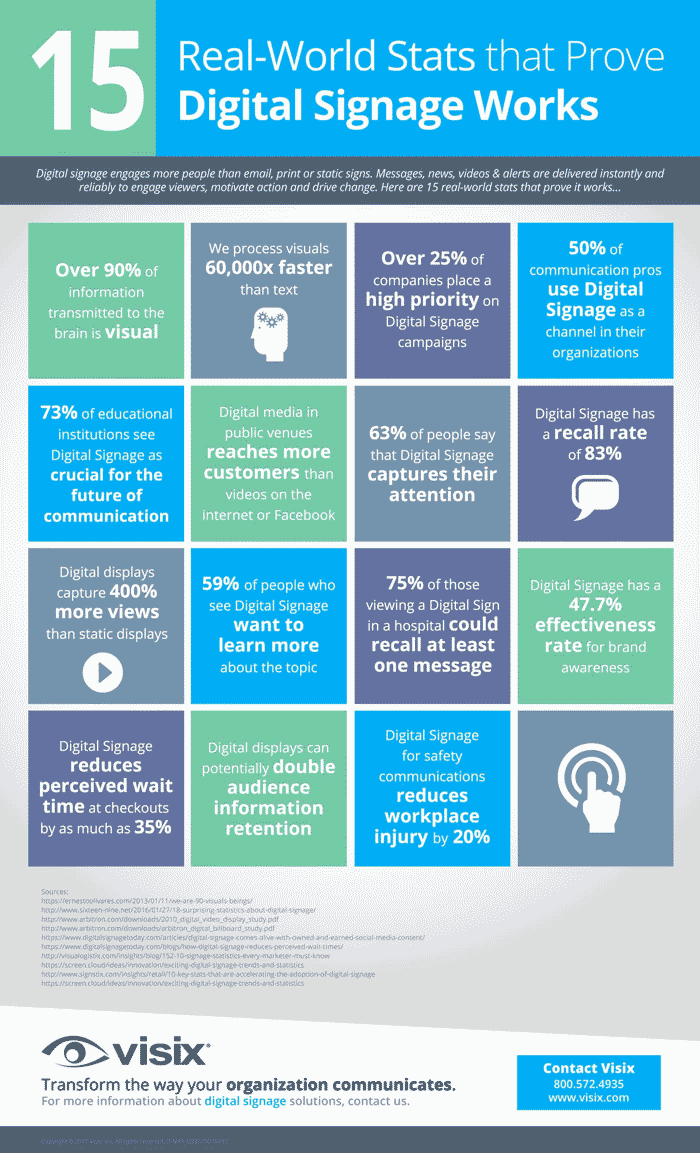Digital signage is a huge market – many organizations either have already adopted it or are planning to in the near future. There are lots of studies reporting impressive digital signage statistics about the effectiveness of the medium, and predictions show that the industry is going to keep growing for at least the next few years.
One of the major reasons for this growth is the convergence of communications with technology. As people are growing more accustomed to social media and digital interactions via the web, visual communications are becoming more common and more relevant. Also, the more screens available to people, the more points of contact are available for digital messaging.
Although retail was the first industry to adopt digital signage, organizations of all types now see the value in a digital medium for both internal and external messaging. Email has become a burden with copious amounts of marketing spam and the sheer volume of internal messages, so savvy business people are finding new ways to capture the attention of both their visitors and their employees.
Soon everyone will have some form of digital signage in their facilities – whether it’s public-facing, for internal communications, or both. And there are some excellent reasons to do so. Here are some digital signage statistics that will make a believer out of even the most skeptical person:
Digital Signage has Reach and Saturation
- 70% of Americans say they’ve have seen a digital display in the past month
- 52% say they’ve seen a digital sign in the past week
- 47% remember seeing a specific ad or message
- Recall jumps to 55% when talking about outdoor digital billboards
- 80% of shoppers say they have entered a store because a digital sign caught their interest
With so many digital signs in so many locations these days, it’s no surprise that people notice them. What’s striking is that they remember seeing them, and even remember specific content they’ve seen. In retail settings, the messages they are exposed to have often prompted an unplanned purchase.
Digital Signage is Visual and So Are We
- 90% of the information transmitted to the brain is visual
- 30% of the brain’s cortex is devoted to processing visual information
- Only 8% of the brain processes touch and 3% processes hearing
- Our brains process visual information 60,000x faster than text
- People can remember a group of over 2000 pictures over a period of several days with 90% accuracy
- After three days, people retain 65% of visually presented information
- People retain only 10-20% of written or spoken info after three days
Humans are pattern-seeking animals – those that could see predators coming and avoid them lived longer to pass on their genes. As a result, the human brain is overwhelmingly concerned with visual processing.
Digital signage is mainly a visual medium, and the human brain responds quickly and efficiently to well-crafted information presented on screens. More than any other kind of communications tool, digital signage taps into our natural predilections – we are biologically biased towards visual information, and that’s exactly what digital signs give us.
Digital Signage is Persuasive
- Presentations that use visual aids are 43% more persuasive than those that don’t
- 68% of US customer signage reflects the quality of business and its products
- Digital signage increases brand awareness by 47.7%
We find information received visually to be more persuasive (think of the old adage “seeing is believing”). As a result, studies show people not only remember more about organizations and brands that use digital signage, but subconsciously consider them to be more honest and trustworthy.
Digital Signage is Becoming Ubiquitous
- Over 25% of US companies place a high priority on “multichannel campaign management”, which includes digital signage campaigns
- 50% of communications professionals use digital signage as a channel
- The global digital signage market is predicted to exceed $20 billion by 2020
With so many organizations using digital signage, from corporate hubs and universities to hospitals and shopping centers, there is some danger of being seen as “old-fashioned” or “out of touch” if you don’t have it. And with millennials taking a more active role in the workplace and society at large, it becomes even more imperative – they grew up using the internet and smartphones and expect visual, digital information to be presented to them on screens.
Digital Signage Increases Sales
- 19% of viewers made an unplanned purchase of something promoted digitally in a retail setting
- In restaurants, the number of unplanned purchases jumps to 80%
- 4 out of 5 brands noticed a 33% increase in sales after adopting digital signage
- Adding a single on-premise sign adds an average of 4.75% in annual sales revenue
Not only are costs coming down all the time for digital signage systems, but new data shows that it actually increases sales, so essentially digital signage ends up paying for itself.
Digital Signage Fosters Engagement
- Companies that communicate effectively are 4x more likely to report high levels of employee engagement
- Companies with higher levels of engagement report better financial results and higher employee retention
- Disengaged employees are 12x more likely to leave their job within the current year
Higher workplace engagement leads to:
- 37% lower absenteeism
- 41% fewer safety incidents
- 41% fewer quality defects
- 28% less internal theft
- 21% higher productivity
Companies with high employee engagement see:
- a 26% increase in annual revenue
- 233% higher customer loyalty
The bottom line is important, and that bottom line is affected by how happy and productive your employees are. A major factor is effective employee engagement – how much employees feel like they are part of something that matters, and how much they enjoy working there. There are serious benefits across the board, from higher customer loyalty and revenue increases to better productivity and less waste from happy workers. Digital signage is an important communications tool – perhaps the most important because it’s the most pervasive – to get people involved and engaged in the organization, which leads to numerous benefits.
Digital Signage Helps with Employee Recognition
- Employees who feel valued are 60% more motivated to work harder
- Almost 1/3 of employees would rather be recognized in a company-wide email from a superior than receive a $500 bonus (meaning public recognition is more effective than money)
- Employees who think their managers can name their strengths are 71% more likely to feel both engaged and energized at work
Humans are social creatures, and a lot of their time is spent at work. Getting accurate feedback and praise for a job well done is psychologically important to most people. Again, digital signage is a fantastic tool for employee recognition. If people would prefer being singled out in an email to extra money, imagine how they’d feel having that same praise displayed on digital signs across the facility.
Digital Signage Can Create an Open Dialogue
- 47% of employees say they don’t know what their company’s core values are
- 50% of employees who say that their superiors sharing information positively impacts their productivity and motivation
- 75% of employees say they would stay longer at a company that listens to and addresses their concerns
- 86% of new professionals and recent college graduates say it is important to them to work for a company that is socially responsible
- 63% of workers say sustainability is a key factor when considering working for a company
Modern workers want to know what their company is up to – what it stands for, and what’s important to it (besides making a profit). This is especially true of millennials, who are driving a new era of corporate responsibility and transparency. The more people know about who they work for, the more they trust them – and the more engaged they are. Again, digital signage is the perfect tool for a modern workforce – letting everyone know what the organization’s values are, and to highlight efforts in areas such as sustainability, charitable donations and volunteerism.
Digital Signage Works
As all of the above statistics show, digital signage is an extremely effective messaging medium. Whether they’re used in stores, businesses, factories, hospitals, schools or government offices, digital signs offer an immediate, impactful messaging medium.
Digital signage is visual, which makes it easier for viewers to digest and remember information. It makes it easy to engage and recognize employee achievements, to communicate an organization’s brand and values, and to persuade people to follow a call to action or make a purchase.
There are also a growing variety and number of digital signage services available to customers today. Everything from interactive design to content subscriptions to managed services means its easier to maintain a dynamic digital signage strategy.
Based on these statistics, and falling prices for digital signage systems – displays, content management software, media players, etc. – adoption of this technology is set to continue booming for the foreseeable future.
Here’s a handy infographic with digital signage statistics to take away:

References
- http://www.arbitron.com/downloads/2010_digital_video_display_study.pdf
- https://oaaa.org/NewsEvents/PressReleases/tabid/327/id/4244/Default.aspx
- https://www.smallbusinessbonfire.com/why-use-retail-signs/
- https://www.digitalsignagetoday.com/companies/media/panasonic/whitepapers/
- http://www.seyens.com/humans-are-visual-creatures/
- http://www.t-sciences.com/news/humans-process-visual-data-better
- http://wezank.com/we-are-visual-creatures/
- https://en.wikipedia.org/wiki/Retina
- https://econsultancy.com/reports/the-multichannel-retail-survey
- http://visualogistix.com/insights/blog/152-10-signage-statistics-every-marketer-must-know
- https://datatrend.com/library/DigitalSignage-SignoftheTimes-0610.pdf
- https://www.viewsonic.com/us/downloads/dl/file/id/550/product/0/dynamic_vs_static_signage_the_advantages_of_digital.pdf
- https://www.grandviewresearch.com/industry-analysis/digital-signage-market
- https://www.tmcnet.com/usubmit/2014/03/12/7720094.htm
- http://inwardconsulting.blogspot.cz/2007/09/effective-communications-leading.html
- https://c.ymcdn.com/sites/www.simnet.org/resource/group/066D79D1-E2A8-4AB5-B621-60E58640FF7B/leadership_workshop_2010/towers_perrin_global_workfor.pdf
- http://news.gallup.com/businessjournal/163130/employee-engagement-drives-growth.aspx
- http://www.aberdeen.com/research/10985/10985-RR-customer-employee-engagement.aspx/content.aspx
- http://www.marketwired.com/press-release/glint-study-reveals-new-hires-with-poor-onboarding-experiences-are-eight-times-more-2167492.htm
- https://www.apaexcellence.org/resources/creatingahealthyworkplace/employeeinvolvement/
- https://www.bamboohr.com/blog/reward-and-recogntion-survey/
- https://www.businesswire.com/news/home/20150306005084/en/Employee-Appreciation-Day-Study-Shows-Employees-Recognize
- https://www.eaglehillconsulting.com/opinion/stress-testing-corporate-core-values-america/
- https://blog.hubspot.com/marketing/management-mistake?__hstc=18058598.045cff25909109290dc5b832c4f86c0d.1488803279132.1488803279132.1488803279132.1&__hssc=18058598.1.1488803279133&__hsfp=1262626452
- https://www.ultimatesoftware.com/happywork
- http://www.nielsen.com/us/en/insights/news/2016/companies-looking-to-boost-their-reputations-should-look-inward.html
- https://www.staples.com/sbd/cre/marketing/workplace-survey/
